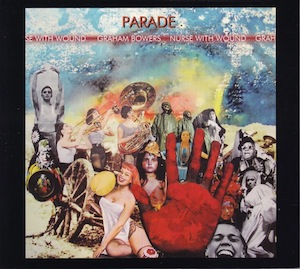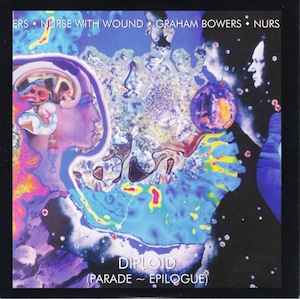 For their second collaboration, Steven Stapleton and Graham Bowers take the elements that worked so well on Rupture and push them outwards into something more bewildering, but equally as compelling. Pomp, ceremony, showbiz and a cryptic approach to musical arrangements, this is a powerfully odd and oddly powerful work by the duo. As much as I enjoyed Rupture, its heavy subject matter prevents it from being a regular addition to my listening schedule but Parade fills that gap perfectly.
For their second collaboration, Steven Stapleton and Graham Bowers take the elements that worked so well on Rupture and push them outwards into something more bewildering, but equally as compelling. Pomp, ceremony, showbiz and a cryptic approach to musical arrangements, this is a powerfully odd and oddly powerful work by the duo. As much as I enjoyed Rupture, its heavy subject matter prevents it from being a regular addition to my listening schedule but Parade fills that gap perfectly.
Given the name of the album, it is perhaps no surprise that the music largely has a touch of fanfare and a strong beat to it. Synthesised brass and strings bring to mind The Residents circa Freak Show (their last great one in my opinion) but sound far less rigid. Divided into eight movements, Parade does truly sound like I am surrounded by marching bands. Granted these marching bands are a far cry from the usual mobile orchestras seen at the St. Patrick’s Day parade or at a New Orleans Mardi Gras but the different segments fade in and out like the sound is being made by musicians in transit. The fact that the different segments also tend to be jarringly different is also reminiscent of the parades I would go to as a child; an American high school band followed by traditional Irish musicians followed by dancers dancing to pop music would not have been out of the ordinary. A psychotic brass band followed by frenetic electronic beats followed by eerie noises from the outer dark would not have been normal for sure.
Such otherworldly sounds permeate the album with pieces such as "Apes and Peacocks" and "The Bells of Hell Go Ting A'Ling A'Ling" sounding like they are celebration music from another dimension and one that might or might not be friendly. On "The Bells of Hell…" first appears one of the album’s leading motifs: amidst the clanking industrial rhythms is a scratchy recording of "Thanks for the Memory." The song appears in various stages of decay throughout the rest of the album, its presence mysterious and made all the more strange considering it keeps popping up among a slew of other oldies and showtunes. Only a sizeable chunk of Gilbert and Sullivan’s "I Am the Very Model of Modern Major General" on "Beyond the Palisade" rivals it for playtime.
Yet, Stapleton and Bowers do not rely on the music of others to propel Parade forward. Each section is a dense and intricate layering of different rhythms, melodies (some tonal, some atonal) and typically Nurse-y scrapes and clangs. "A Tissue of Deceit" stands out as being particularly good, combining hammy horror soundtrack with actually unnerving mood all on top of an upbeat but wobbly beat. It manages to be funny, terrifying and catchy all at the same time. It reaches its peak when, about three minutes in, insistent rhythms and a cacophonous range of sounds come together in a trippy climax.
 The bonus disc, Diploid, is listed as an epilogue to the main event and with good reason. The single 20 minute piece feels like Parade in redux as the different themes and sounds explored during the album are regurgitated, re-assimilated and reformed into something new. Additions of creepy acoustic guitar and discordant piano add further drama to the sounds, whatever feelings of excitement present in Parade become soured and unwelcoming as if the parade has turned back on itself and was marching into the underworld. It seems almost a crime that this is not part of the standard Parade album because it is a solid way to finish off such a head-scratcher of a release.
The bonus disc, Diploid, is listed as an epilogue to the main event and with good reason. The single 20 minute piece feels like Parade in redux as the different themes and sounds explored during the album are regurgitated, re-assimilated and reformed into something new. Additions of creepy acoustic guitar and discordant piano add further drama to the sounds, whatever feelings of excitement present in Parade become soured and unwelcoming as if the parade has turned back on itself and was marching into the underworld. It seems almost a crime that this is not part of the standard Parade album because it is a solid way to finish off such a head-scratcher of a release.
samples:
 
Read More

